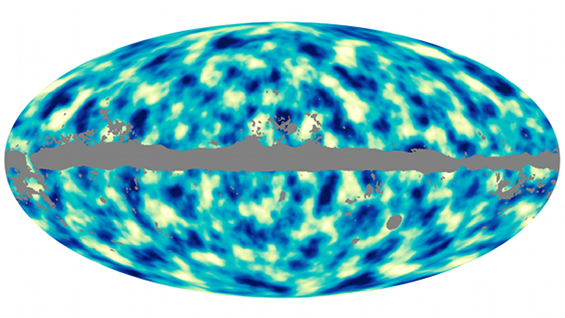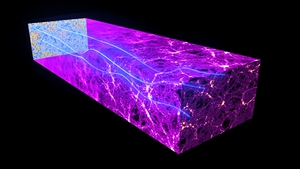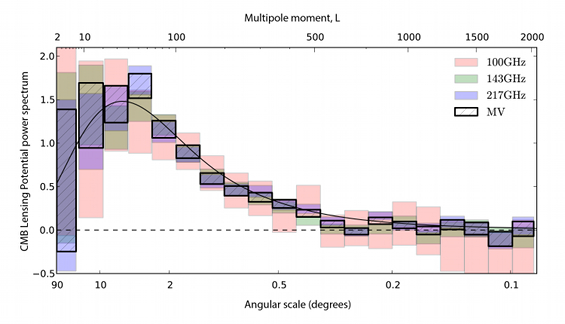Planck sees a cosmic journey 13 billion years in the making
2 April 2013
Cosmologists using data from ESA's Planck satellite have compiled the first all-sky image of the distribution of dark matter across the entire history of the Universe as seen projected on the sky. This is made possible by analysing the tiny distortions imprinted on the photons of the Cosmic Microwave Background (CMB) by the gravitational lensing effect of massive cosmic structures. As photons travelled through these structures, which consist primarily of dark matter, their paths became bent, slightly changing the pattern of the CMB. Although noisy, this image is the first measurement performed over almost the whole sky of the gravitational potential that distorts the CMB, and is one of the highlights of Planck's cosmological results. With these unique data, cosmologists can investigate 13 billion years of the formation of structure in the Universe. The data agree very well with the expectations from the leading cosmological model that describes the origin and evolution of cosmic structure in the Universe.
 |
| All-sky map of dark matter distribution in the Universe. Credit: ESA and the Planck Collaboration. |
While scanning the sky to study the most ancient light emitted in the Universe – the Cosmic Microwave Background (CMB) – ESA's Planck satellite is also probing the entire history of how structure formed and evolved in the cosmos. Because the photons that make up the CMB were emitted only 380,000 years after the Big Bang, they have travelled for over 13 billion years across the Universe, witnessing the dramatic changes that took place during the various cosmic epochs such as the formation of stars, galaxies and galaxy clusters.
Several observable effects arise from the interaction between CMB photons and the large-scale structure they crossed during their journey. One of the most intriguing is gravitational lensing, the deflection of light as it travels in the vicinity of massive objects such as galaxies and galaxy clusters. Similar to what happens when light rays pass through a glass lens, the trajectories of photons are bent as they encounter these 'gravitational' lenses: as a result, the image that an observer sees when looking at a cosmic object, such as a galaxy, through a gravitational lens is distorted. In the most spectacular cases, the same galaxy can be imaged more than once, or its shape can be twisted and appear as a giant arc.
"In the case of the CMB, gravitational lensing due to cosmic large-scale structure creates tiny, additional distortions to the mottled pattern of the CMB temperature fluctuations. The effect is extremely small, but we have been able to isolate it exploiting Planck's combination of high sensitivity and angular resolution over the entire sky," comments Jan Tauber, Planck Project Scientist at ESA.
 |
|
|
Left: Gravitational lensing of the Cosmic Microwave Background. (See also the animated version of this image.) Right: Distortion of the Cosmic Microwave Background due to gravitational lensing. Credit: ESA and the Planck Collaboration |
|
"The CMB consists of the most ancient photons emitted in the Universe's history: we can think of them as the ultimate 'cosmic storytellers'. The tale these photons are telling us begins with the epoch when they originated, 380,000 years after the Big Bang, when the cosmos consisted of an almost smooth fluid of particles: but that is only the start," explains Tauber. "Thanks to the detection of gravitational lensing experienced by CMB photons, we can use Planck to explore the subsequent epochs in the history of the Universe, during which the invisible dark matter built up the 'cosmic web' and stars and galaxies started to form in the densest nodes of this intricate network of structure."
On their way to the Solar System, where they are eventually detected by the sensors on board Planck, photons from the CMB may cross many different massive systems as well as empty spaces. The photons encounter structures in different evolutionary stages, since the massive structures grow denser and the cosmic voids become less dense as time goes by. All of the structures from the different cosmic epochs contribute to bending the path of CMB photons. The total effect of these multiple deflections is a modification to the pattern of CMB temperature fluctuations, thus changing the typical 'shapes' of hot and cold spots in the CMB. These changes only affect the CMB on very small scales – of the order of a few arc minutes – where the primordial CMB does not exhibit significant structure, making the separation of the signal due to gravitational lensing from the primordial CMB signal a very complex procedure.
"Isolating the gravitational lensing effect in the CMB is extremely difficult since we are looking for the deformation of a signal that has very little structure itself," explains Karim Benabed of the Institut d’Astrophysique de Paris, France. "We use statistical methods to exploit the minute changes in the shape of the CMB pattern and reconstruct the gravitational potential of the structure that caused these distortions," he adds.
The result is an image of the three-dimensional large-scale distribution of dark matter across the cosmos as seen projected on the two-dimensional plane of the sky. The reconstruction technique used to compile this image relies on deviations of the shapes of hot and cold spots in the CMB from their 'typical' shape, and it is impossible to avoid the introduction of statistical 'noise' in the reconstruction, since only some deformations detected in the data are due to gravitational lensing. On average however, the reconstruction is quite accurate.
"Extracting information about the large-scale distribution of dark matter from the CMB is similar to trying to identify what lies on the ground beneath a thick layer of snow. Part of the structure we see in the white surface is caused by actual corrugations of the ground or by stones and other objects that are coated by snow," says Benabed. "However, we might also see other features that are simply due to an uneven distribution within the snow layer and mistakenly deduce that they correspond to some real structure underneath."
"The image we have reconstructed is nevertheless good enough to have considerable statistical power, as we can measure the amplitude of the power spectrum of the dark matter distribution with a precision of four per cent," comments Duncan Hanson of McGill University, Canada.
 |
|
Planck's gravitational lensing power spectrum. Credit: ESA and the Planck Collaboration. |
The task of disentangling the contributions imprinted on the CMB by massive objects and voids at different distances – which correspond to different epochs in cosmic history – is very complex. Cosmologists rely on the fact that gravitational lenses, just like ordinary lenses, are most efficient when located midway between the source of light and the observer. For this reason, the structures that contribute most to gravitationally lens the CMB are those located at redshift z~2, corresponding to the epoch when the Universe was about three billion years old; taking into account cosmic expansion, this redshift identifies structures that are 'half-way' between the present epoch and the time when the CMB was released. However, more massive gravitational lenses are stronger, and these are more abundant in the later epochs of cosmic history so another substantial contribution to the gravitational lensing of the CMB comes from structures at redshifts between z~2 and z~1, corresponding to the epoch when the Universe was between three and six billion years old.
"The projected dark matter distribution inferred from the Planck data agrees very well with our expectations," explains Hanson. "In the leading cosmological scenario, the seeds of cosmic structure have been embedded during cosmic inflation – a very early epoch of accelerated expansion that took place immediately after the Big Bang – and later grew denser and more massive under the effect of gravity. Eventually, this gave rise to a highly structured network consisting mainly of dark matter, and galaxies formed in the densest knots of this web. The large-scale distribution of structure in such a Universe would lens the CMB just as we see it with Planck," he adds.
The study of the gravitationally-lensed CMB provides cosmologists with a wealth of information about the 13-billion-year history of cosmic structure formation. This complements the view of the Universe that can be extracted from the analysis of the primordial CMB signal. By investigating the minute fluctuations in the primordial CMB, cosmologists can constrain several properties of the Universe, such as the density of dark matter, the speed of cosmic expansion and the relative amount of primordial fluctuations – the seeds of nascent cosmic structures – on different scales. However, the primordial CMB is a relic of the early Universe and does not contain direct information about the further evolution of structure in the cosmos. Since gravitational lensing arises later in cosmic history, it provides cosmologists with an extra set of information about the late Universe. This will enable them to estimate additional parameters, such as the properties of dark energy – the repulsive force driving the currently accelerated cosmic expansion, against which structures keep building up – or the mass of neutrinos, the particles that play an important role in damping the formation of cosmic structure on small scales.
"The detection of gravitational lensing of the CMB over nearly the whole sky is an extraordinary milestone achieved by Planck: astronomers and cosmologists will scrutinise this unique data set for years to come," says Tauber. "In particular, by combining the study of the gravitationally-lensed CMB with other probes of the large-scale structure such as galaxy surveys, we will be able to investigate the complex relation between the distribution of dark and luminous matter in our Universe."
Notes for editors
This article is based on results described in the Planck Collaboration paper: "Planck 2013 results. XVII. Gravitational lensing by large-scale structure", submitted to Astronomy & Astrophysics.
The new data from Planck are based on the first 15.5 months of its all-sky surveys. Launched in 2009, Planck was designed to map the sky in nine frequencies using two state-of-the-art instruments: the Low Frequency Instrument (LFI), which includes the frequency bands 30–70 GHz, and the High Frequency Instrument (HFI), which includes the frequency bands 100–857 GHz. HFI completed its survey in January 2012, while LFI continues to operate.
Planck's first all-sky image was released in 2010 and the first scientific data were released in 2011. Since then, scientists have been extracting the foreground emissions that lie between us and the Universe's first light to reveal the Cosmic Microwave Background. The first cosmology results from Planck were presented at a press conference on 21 March 2013; further details will be presented at the 47th ESLAB Symposium, 2-5 April 2013. The next set of cosmology data will be released in early 2014.
The Planck Scientific Collaboration consists of all the scientists who have contributed to the development of the Planck mission, and who participate in the scientific exploitation of the Planck data during the proprietary period. These scientists are members of one or more of four consortia: the LFI Consortium, the HFI Consortium, the DK-Planck Consortium, and ESA's Planck Science Office. The two European-led Planck Data Processing Centres are located in Paris, France and Trieste, Italy.
The LFI consortium is led by N. Mandolesi, Agenzia Spaziale Italiana, Italy (deputy PI: M. Bersanelli, Università degli Studi di Milano, Italy), and was responsible for the development and operation of the LFI instrument. The HFI consortium is lead by J.L. Puget, Institut d’Astrophysique Spatiale in Orsay, France (deputy PI: F. Bouchet, Institut d'Astrophysique de Paris, France), and was responsible for the development and operation of the HFI instrument. The Institut d’Astrophysique Spatiale in Orsay is a Unité Mixte de Recherche (UMR8617) of the CNRS (Centre National de la Recherche Scientifique) and the Université Paris-Sud 11. The Institut d’Astrophysique de Paris is a Unité Mixte de Recherche (UMR 7095) of the CNRS and the Université Pierre et Marie Curie of Paris.
The development of the Planck mission was supported by substantial financial and technological contributions of ESA Member States. More than 40 per cent of the mission's development cost was provided by the agencies supplying HFI and LFI. France and Italy, through the two leading funding agencies CNES and ASI, and the national research bodies, provided more than half of the national funding. The contribution of ESA Member States is even more significant for the scientific operation of the mission and the processing of its data. ESA Member States also provided key technologies such as the innovative cooler that enabled the mission’s instrumentation to be maintained at just one-tenth of a degree above absolute zero (-273.15°C). Important technologies and payload elements were also contributed by NASA.
Background information to the topics discussed in this release – the Cosmic Microwave Background and the history of structure formation in the Universe – is available in the Planck Toolkit.
The 47th ESLAB Symposium, “The Universe as seen by Planck” is an international conference dedicated to an in-depth look at the results from the Planck mission, and will be held from 2 to 5 April 2013 at ESA/ESTEC in Noordwijk, The Netherlands. More information here.
Contacts
Karim Benabed
Institut d’Astrophysique de Paris, France
Email: benabed![]() iap.fr
iap.fr
Duncan Hanson
McGill University
Montréal, QC, Canada
Email: dhanson![]() physics.mcgill.ca
physics.mcgill.ca
Jan Tauber
ESA Planck Project Scientist
Research and Scientific Support Department
Directorate of Science and Robotic Exploration
ESA, The Netherlands
Email: jan.tauber![]() esa.int
esa.int
Phone: +31-71-565-5342




